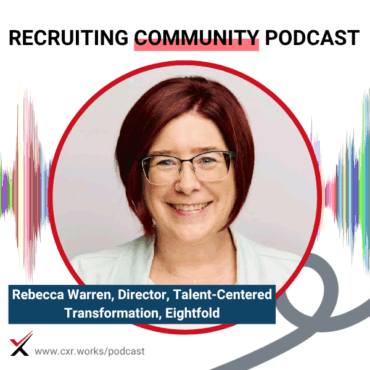
Business Cost of TA and HR Misalignment
Only 53% of HR teams help shape business strategy. Rebecca Warren unpacks what that misalignment means—and how data, tech, and skills can close the gap.
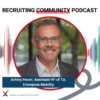 play_arrow
play_arrow
 play_arrow
play_arrow
Transforming High-Volume Hiring at 7-Eleven Cami Grace
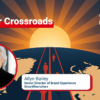 play_arrow
play_arrow
From Early Childhood to Talent Tech: Allyn Bailey’s Career Crossroads Cami Grace
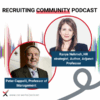 play_arrow
play_arrow
In Praise of the Office Cami Grace
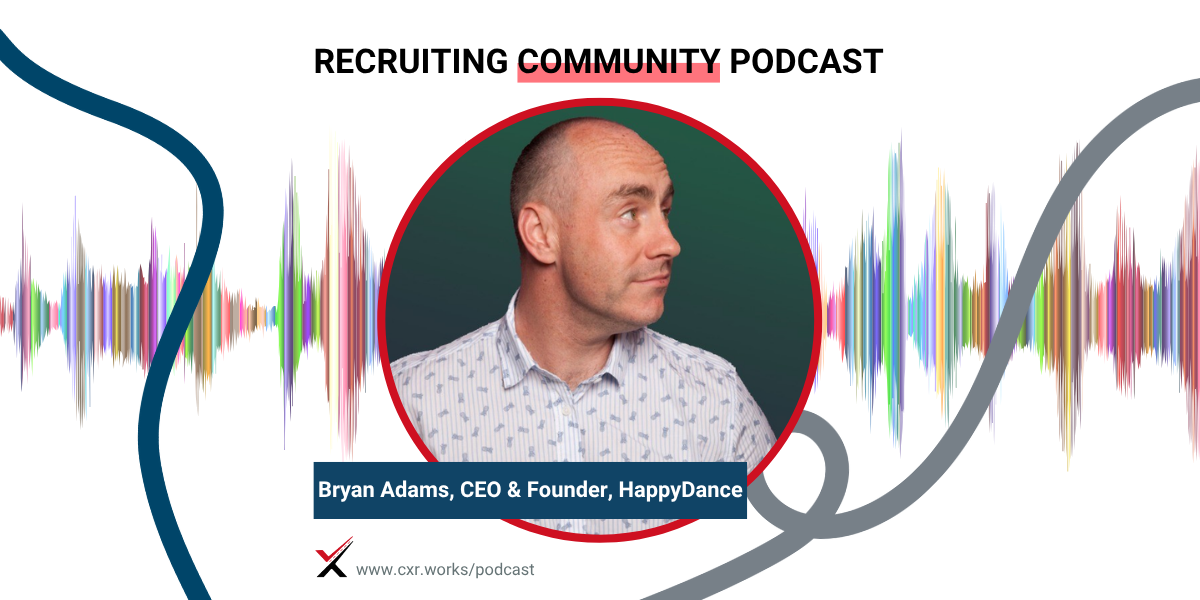
In this episode, we welcome Bryan Adams, CEO HappyDance and a TEDx speaker whose talk, “Culture Eats Competition for Breakfast,” has garnered over 1.2 million views. Bryan shares his expertise on elevating employer branding (EB) to the forefront of business strategy. We delve into the findings of the latest CXR research report on establishing employer branding as a strategic business driver and discuss practical steps leaders can take to ensure alignment with corporate goals.
From tackling the misconception that EB is a “nice to have” to actionable strategies for demonstrating its ROI, this conversation is a must-listen for leaders aiming to make employer branding a core element of their organization’s success.
[2:10] – Bryan’s career journey: From consultancy to leading a tech company focused on employer branding.
[6:30] – The challenges of getting leadership buy-in for EB initiatives.
[11:45] – Strategies for tying EB work to existing business metrics to showcase impact.
[16:20] – Aligning employer branding with corporate vision and larger business objectives.
[22:00] – The cost of standing still: Why inaction leads to falling behind.
[30:35] – Practical steps for TA leaders to claim their seat—and voice—at the table.
If you found this episode insightful, please rate, follow, and review our podcast! Share it with your colleagues and help us elevate employer branding to its rightful place in business strategy.
Title:
Employer Branding as a Strategic Business Driver
Featured Guests:
Bryan Adams, Founder, Happy Dance
Hosts:
Chris Hoyt, President, CareerXroads
Gerry Crispin, Co-Founder, CareerXroads
Episode Overview:
Chris Hoyt talks with Bryan Adams about the growing business imperative of employer branding. Fresh off the success of his TEDx talk “Culture Eats Competition for Breakfast,” Bryan discusses why employer branding should be viewed as a strategic capability, not an optional function. The conversation explores insights from CareerXroads’ recent research report on employer branding, including alignment with leadership goals, proving ROI, and the evolution from HR tactic to business strategy.
Key Topics:
Elevating employer branding to a strategic business priority
Insights from the CXR research report on employer brand strategy
Metrics that matter to leadership and aligning with corporate KPIs
How Happy Dance was inspired by real EB wins
TEDx talk reflections and the culture-as-strategy argument
The importance of acting now to lead future talent capability
Notable Quotes:
“Leaders should be demanding employer branding, given how powerful it can be.” — Bryan Adams
“Don’t invent new metrics. Show how EB impacts metrics your leadership already tracks.” — Bryan Adams
“If you’re not at the table, you might be on the menu.” — Bryan Adams
“Culture is a strategy—specifically employer brand. And in today’s world, where people are your only competitive advantage, that’s powerful.” — Bryan Adams
Takeaways:
Bryan Adams emphasizes that employer branding is no longer just a function of talent attraction—it’s a key driver of business success. Strategic EB must align with leadership goals, impact real business metrics, and support future capabilities. With leadership buy-in and the right positioning, employer branding becomes a central lever for competitive advantage in today’s fast-moving environment.
Want more conversations like this?
Subscribe to the CXR podcast and explore how top talent leaders are shaping the future of recruiting. Learn more about the CareerXroads community at cxr.works.
Chris Hoyt: So, Bryan, every time I see you, I feel like you’re looking more fit. You always look healthy and happy. As a man of a certain age who’s trying to live longer—any wisdom here? Is it just about getting my ass in the gym every day?
Bryan Adams: I mean, look at me right now. I feel like Casper the Ghost’s paler uncle. But yeah, I’m dealing with the great British weather, and I’ve just come off the holiday season where my mom’s roast potatoes helped me put on eight pounds. So now I’m back in the gym like the rest of us, just trying to get back to some kind of normal.
Chris Hoyt: Yeah, I find I’m sharper and more productive when I’m constantly moving. My work rhythm shifts—I’m more productive later in the day when I’m on a regimen. I just feel better overall.
Bryan Adams: Same here. I’ve gotten into a routine: wake up super early, hit the gym, do a sauna, and then take copious amounts of supplements. Seriously, my cabinet looks like a pharmacy. Basically, I just produce very expensive urine—but I feel good. Then I dive into work for a few hours and try to be disciplined. The main thing is: don’t look at social media or emails until you’ve done something productive.
Chris Hoyt: Social media is a whole separate disaster. I can’t even look at it anymore with everything going on in U.S. politics—it’s a train wreck. But have you seen what’s happening over here?
Bryan Adams: No, I’ve missed it.
Chris Hoyt: Well, we’ve started a Strava group. It’s social media for fitness. We call it TAME—Talent Acquisition in Motion. Not tame like boring—we’re all just trying to stay active. You’re more than welcome to join.
Bryan Adams: Alright, count me in.
Chris Hoyt: You’ll probably be the most consistent one in there. We’ve got Lori R., Jerry logs his walks—he smoked me the other day. He’s a tank. Seriously.
Bryan Adams: You’re setting me up for failure here!
Chris Hoyt: All good fun. Okay, we’ve got a great topic today. You ready to jump in?
Bryan Adams: Born ready.
Announcer: Welcome to the CXR channel, our premier podcast for talent acquisition and talent management. Listen in as the CXR community discusses a wide range of topics focused on attracting, engaging, and retaining the best talent. We’re glad you’re here.
Chris Hoyt: Alright everybody, welcome back to the Recruiting Community Podcast. We’re bringing you industry insights and updates through fun, hopefully insightful conversations—brought to you by the CXR CareerXroads community.
Joining me today is Bryan Adams—not the rockstar, but definitely a rockstar in our space. Bryan, you’ve recently been listed in the top 50 TEDx Talks worldwide for most watched in 2024. That’s no small feat.
We’re going to talk about that, and also share key findings from our latest research report on establishing employer branding as a strategic business driver. We’ll cover:
Evaluating and refining employer branding
Aligning it with broader corporate strategies
And positioning employer branding as a strategic leadership priority
Quick housekeeping—if you’re watching us live, say hello in the LinkedIn chat. This podcast is an ad-free labor of love. No paid promos, no fast-forwarding through commercials. Just great conversations with folks doing important work.
Welcome back, Bryan!
Bryan Adams: Good to be back, Chris.
Chris Hoyt: Before we dive in and I embarrass you with the TEDx fame, give us a quick pitch—who is Bryan Adams, and why should we be listening?
Bryan Adams: Well, you be the judge of that. Right now, I’m at an interesting point in my career. I’ve been obsessed with employer branding and candidate experience for nearly 20 years. I’ve pivoted from running a consultancy into launching a tech company. We’re building a tool specifically for employer brand and candidate experience—filling a gap in the market.
Running a tech company is wildly different than consultancy, but the vision remains the same: everyone loves their job. With Happy Dance, I think we’re making a quantum leap toward that goal.
Chris Hoyt: I remember your product really hit the radar at our employer branding meeting a couple of years ago. You launched with Intuitive Surgical the morning of the event, and the speaker literally did a “happy dance” while talking about it. That was a fun moment.
Bryan Adams: That’s where the name came from! Brad Cook did a spontaneous happy dance, and others followed. So we named the company after that sentiment.
Chris Hoyt: Alright, let’s talk about “Culture Eats Competition for Breakfast”—your TEDx talk. It’s got 1.2 million views. That’s huge! What was the idea behind it?
Bryan Adams: Apart from our company vision, my personal mission is to elevate employer branding strategy beyond HR—into primary business strategy. It’s frustrating that EB isn’t taught in universities or included in MBAs. The talk challenges the quote “culture eats strategy for breakfast.” My argument: culture is a strategy—specifically employer brand. And in today’s world, where people are your only competitive advantage, that’s powerful.
Chris Hoyt: I love that perspective. And again, congrats on the success of the talk.
Bryan Adams: Thank you. I didn’t expect the response. I’ve had great feedback and I’m really humbled by it.
Chris Hoyt: Alright, shifting gears to our research. The latest panel focused on employer branding as a strategic business driver. We had 30–50 leaders and practitioners participate over several weeks, and the report is about 30 pages of insights.
You can learn more or apply to join future panels at cxr.works/research.
Bryan, was there anything that stood out to you from the research conversations?
Bryan Adams: Yeah, several things. The biggest one: there’s still a perception that employer branding is optional. A lot of discussion centered around getting leaders to buy in. That tells me we’re still approaching this the wrong way—leaders should be demanding employer branding, given how powerful it can be.
Chris Hoyt: I agree. One big challenge we saw in the research was proving ROI. What strategies or metrics have you seen work best for showing leadership the business impact of EB?
Bryan Adams: Don’t invent new metrics. That’s a mistake. Instead, show how EB impacts existing business metrics—things leadership already cares about.
It’s about storytelling, benchmarking against competitors, and showing the risk of doing nothing. Leaders care deeply about people when those people drive business capabilities. So align your EB strategy to those capabilities.
Chris Hoyt: That lines up with a lot of what our panelists said. Build your EB strategy to support corporate objectives—not just to “get people in seats.”
Bryan Adams: Exactly. The key is alignment. If you think your job is to simply reflect what employees say about your culture, you’re missing the point. Leaders often want a different culture—one that drives future capability. So you need to understand what leadership needs from talent and then craft an EB strategy to support that.
Chris Hoyt: That’s so powerful. We joked last week that “getting a seat at the table” isn’t enough—it’s just furniture unless you’re part of the conversation.
Bryan Adams: Right. And if you’re not at the table, you might be on the menu.
Chris Hoyt: That’s brilliant. It’s not just about running in your lane—it’s about impacting the business across the board. And if you’re standing still, you’re not staying the same—you’re falling behind.
Bryan Adams: Totally. The world is moving fast. Technology has leveled up globally. People are more important than ever. This is the moment to make your business case and show your value.
Chris Hoyt: Last question, as always: If you were to write a book on this topic—wink, wink—what would the title be?
Bryan Adams: It would probably be the same as my TEDx talk: Culture Eats Competition for Breakfast. But the aim would be the same—elevate employer branding into the wider business conversation.
Chris Hoyt: And who gets the first signed copy?
Bryan Adams: My son, Harrison. He’s only 12, but he’s a brilliant writer. I want to encourage that.
Chris Hoyt: Love that. You can download the full report at cxr.works/research. It’s packed with insights from some really impressive folks.
If you’d like to be part of future panels, we’ve got topics coming up on workforce planning and technology stack solutions. Apply online.
Bryan, final thoughts?
Bryan Adams: Just a big thank you to you, Chris, for being a fantastic research partner. I’ve learned a lot, and I’m grateful. Hopefully, more TA leaders step up and drive EB to the business level this year.
Chris Hoyt: Appreciate that. We’ll wrap up here. Thanks everyone, and we’ll see you next week.
Announcer: Thanks for listening to the CXR channel. Please subscribe to CXR on your favorite podcast platform and leave us a review. Learn more at cxr.works or follow us @careerxroads. Catch you next time.
Tagged as: Company Culture, Branding, Brand, Podcast, Employer Brand, CXR research, Happy Dance, employee engagement, Employer Branding, Talent Acquisition, Branding Strategies, Candidate Experience.
Chris Hoyt is the President of CareerXroads, a global peer community for talent acquisition leaders driving strategic change. With decades of experience leading recruiting innovation at Fortune 500 companies, Chris now advises enterprise TA teams on tech, process, and leadership. He’s a frequent speaker at conferences like SHRM, HR Tech, LinkedIn, and UNLEASH, and he’s known for pushing conversations beyond buzzwords to get to what really works in hiring. Through CXR, he connects top TA professionals to solve real problems, challenge norms, and shape the future of recruiting.

Only 53% of HR teams help shape business strategy. Rebecca Warren unpacks what that misalignment means—and how data, tech, and skills can close the gap.